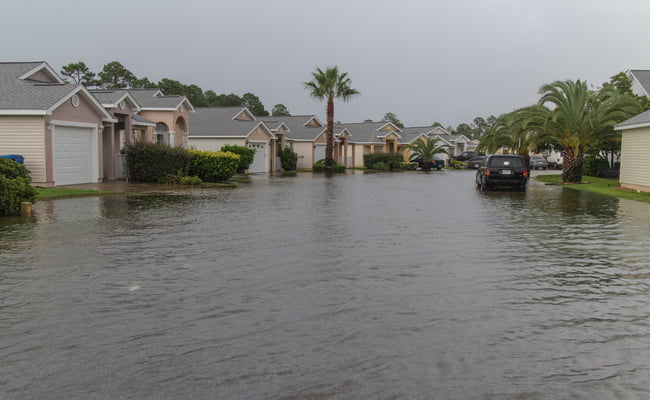
When your local weather service issues a watch or watching for a tornado, hurricane, or other natural disaster, it probably makes you stop what you’re doing and start going through your mental checklist. Family emergency plan, safe shelter, preparedness kit – you want to make sure you have everything in place to keep you and your loved ones protected.
But there’s one watch or warning that doesn’t receive as much instant attention but can cause just as much – if not more – damage: watches and warnings for floods. Besides heat-related incidents, flash floods cause more fatalities every year than any other climate hazard. Knowing the difference between a flood watch and warning can help you better prepare for potential damage to your home.
 What is a Flood Advisory?
What is a Flood Advisory?
A flood advisory is issued when flooding is not expected to be severe enough to warrant a warning. This is the lowest level of weather alerts for flooding. However, the rain may cause an inconvenience and could lead to property damage if not prepared for adequately.
There are a few different types of flood advisories:
- Areal flood advisory: Usually issued for flooding that develops gradually from moderate to heavy rainfall.
- Coastal flood advisory: Issued when flooding is occurring or imminent along the coast of the Atlantic Ocean, Pacific Ocean, or the Gulf of Mexico.
- Flash flood advisory: Issued when a sudden local flood is expected due to heavy rain.
- River flood advisory: Issued when heavy rain causes river levels to rise to potentially dangerous heights.
While these all have a low level of concern, the danger of a flood can grow if the weather takes a turn for the worse. There are also different types of flooding that can occur, depending on the location and conditions.
What Should I Do During a Flood Advisory?
During a flood advisory, stay tuned to a local news source to make sure the warning doesn’t shift to something more serious. Have your supplies and plan in place just in case you have to evacuate. At this level, being aware that a flood may form will allow you to quickly visualize what you may need in case of an emergency.
 What is a Flood Watch?
What is a Flood Watch?
A flood watch occurs when conditions are favorable for flooding. It doesn’t mean that a flood will happen, but it’s possible. This level of alerts is more severe than an advisory but less serious than a warning.
What Should I Do During a Flood Watch?
During a flood watch, keep an eye on local news in case the watch turns into a warning and you need to move to higher ground. Having your plan in place and supplies gathered is even more important under these conditions than during an advisory. By doing this, you’ll be able to respond quickly and be able to seek shelter without having to worry about going through your home last minute to salvage important supplies.
 What is a Flood Warning?
What is a Flood Warning?
A flood warning is issued when flooding is imminent or occurring. The intensity of the rain and the likelihood of greater damage will dictate whether the flood warning is elevated to a flash flood warning. During this warning, you are instructed to move to an area of higher ground if you’re in a flood prone area due to the high likelihood of a flash flood happening. A flash flood is a sudden violent flood that can take from minutes to hours to develop. In fact, a flash flood can occur so quickly that there isn't time to send out a flood warning alert.
If you notice that conditions are worsening, this may be the time to consider evacuation. This is especially important if you’re home is in an area that is prone to flooding since this could mean that you’re at a higher risk. Have a place in mind – at higher ground – where your family can safely depart to if necessary.
What Should I Do During a Flood Warning?

If a flood warning is in effect for your area, it’s time to take action. Most flood fatalities happen because people underestimate the power of fast-moving water and heavy rain, or they’re not prepared for an emergency situation.
Like previously stated, it’s important that your family has an emergency plan and preparedness kit. These need to be at-hand and ready to go. If possible, stay tuned to the local news for updates. They’ll provide up to date information from a trustworthy source that can help inform you whether its safe to go back home or if you need to stay in a safe place for longer.
For extreme flooding, evacuation may be required. It’s important to get out of your home and to a location with a higher elevation before the flooding becomes too severe and the roads are no longer drivable.
Do not drive or walk in heavily flooded areas. It only takes six inches of fast-moving water to knock over most adults, and 12 inches of fast-moving water to carry away smaller vehicles.
If Flood Damage Hits, Call the Experts
According to FEMA, flood water damage is one of the most common and costly hazards in the U.S. It can cause structural issues, electrical damage, and can lead to mold damage to your home in the long-term.
If your home has suffered from flood damage, it’s important to have a partner you can trust. ServiceMaster Restore has a network of severe weather damage experts who can help you recover. Contact a ServiceMaster Restore location near you today and see how we can help you recover after a flood.